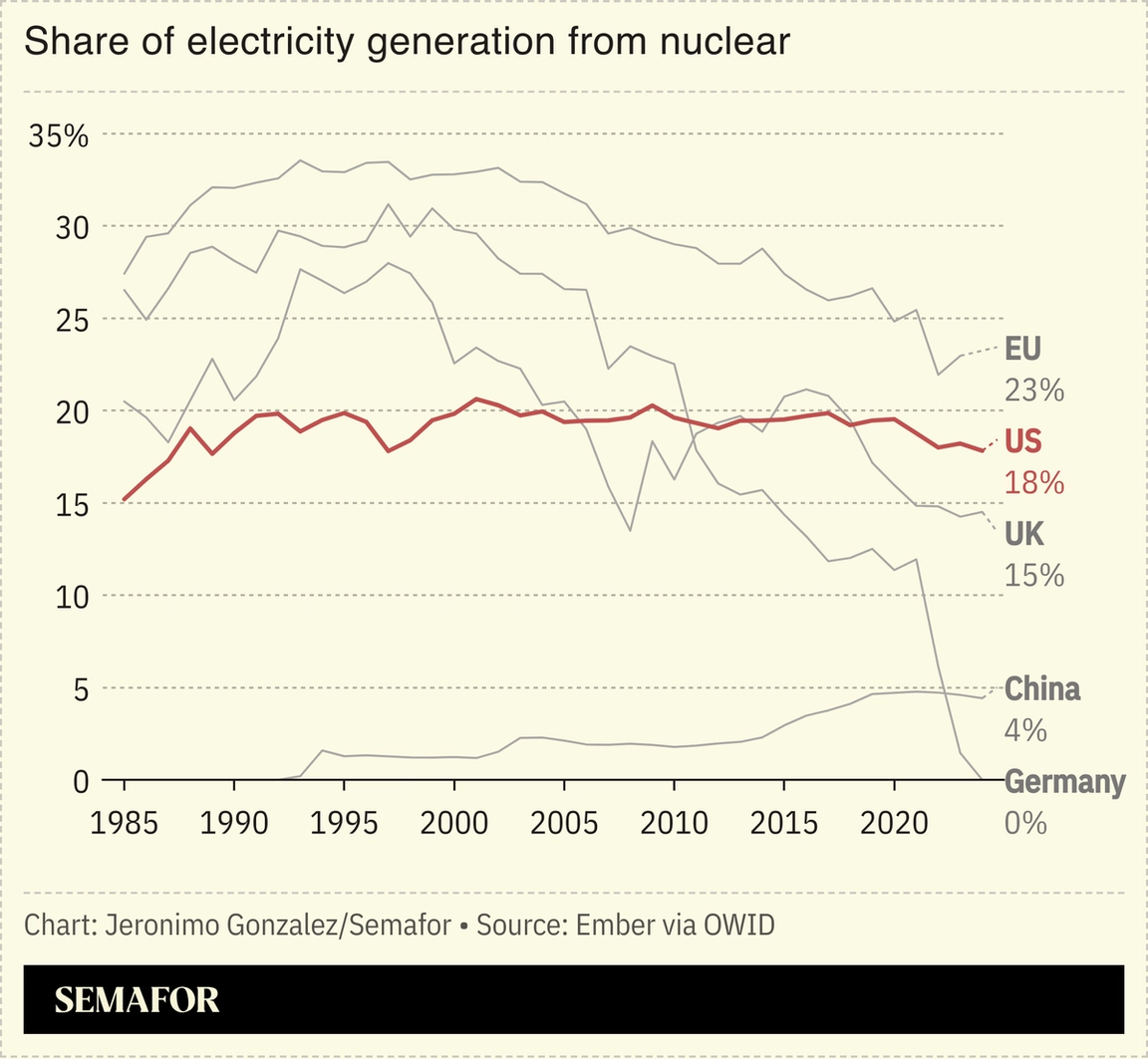| | Oil prices tumbled as Iran and Israel agreed to a ceasefire.͏ ͏ ͏ ͏ ͏ ͏ |
| |   Tehran Tehran |   London London |   Washington DC Washington DC |
 | Net Zero |  |
| |
|
 - Ceasefire cools oil prices
- Bad climate tech vibes
- NY goes nuclear
- LNG’s methane problem
- Trump’s ‘revenge’
 How to eat more sustainably, and how not to source SAF sustainably. |
|
Ceasefire cools oil prices |
Oil prices fell to their lowest point since Israel and Iran began trading rocket attacks two weeks ago as the two countries reached a fragile ceasefire agreement — despite tensions following American targeting of Iran’s nuclear facilities and Tehran firing rockets against a US military base.  Prices had jumped to a five-month high after hostilities broke out, with traders adding a geopolitical risk premium of up to $12 per barrel on top of the previous trading price of roughly $65 for US and international crude benchmarks. But even at their peak, prices remained far below the triple-digit levels that a broad war in the Middle East threatened to unleash. With a de-escalation of the conflict now looking likely, analysts expect oil prices to fall back to the low $60s. The fact that the conflict flared up and died down (for now, at least) without an energy crisis speaks to the geopolitical power of “drill, baby, drill.” Ever since the Arab oil embargoes of the 1970s, a full-blown war across the Middle East has been the energy market’s nightmare scenario. Numerous major refineries and shipping terminals are either controlled by Iran or are potential targets for attacks. Tehran has also repeatedly threatened to close the Strait of Hormuz, through which one-third of the world’s seaborne crude oil and a fifth of LNG move daily. That move could have sent oil prices skyrocketing well above $120. Yet over the past two weeks, higher energy prices were the dog that didn’t bark. One key reason was that the conflict seems to have been resolved relatively quickly, leaving less time for traders to fret about future attacks. But the other key reason was that the record US oil production levels reached under both US President Donald Trump and former President Joe Biden granted Washington a geopolitical insurance policy — while the global clean energy transition leaves exporters like Iran with less leverage. |
|
| |  | Prashant Rao |
| |
 Phil Noble/File Photo/Reuters Phil Noble/File Photo/ReutersPrivate equity giant General Atlantic is “facing [industry-wide] headwinds” as it seeks to raise a second climate-focused fund because of anti-ESG rhetoric in the US, its global head of climate said in an interview. General Atlantic closed its $3.5 billion BeyondNetZero fund in 2022, and is considering raising another fund that will follow a similar strategy of targeting sectors of the green economy focused on decarbonization, energy efficiency, and emissions management, Gabriel Caillaux told Semafor, adding he was confident the firm would ultimately succeed. When fundraising for its initial climate-focused fund, its “hit rate [with investors] was probably 100%,” he said. This time, however, an “overlay of noise” has proved challenging as it looks to raise again: “Our opportunity set hasn’t changed, the performance of the portfolio is great, zero doubt that this trend — or the need to continue to push climate investing — is going to exist for 30 years,” he added. “The biggest issue is right now, we’re in this focus lull, where the noise is pushing investors slightly away from the market.” |
|
New York will build a nuclear plant to power up to 1 million homes, Gov. Kathy Hochul said Monday, in a reversal of the state’s animosity toward the sector.  The plant will be the country’s first new facility of its kind built in more than 15 years. The announcement comes four years after the state closed a nuclear power station following pressure from then-Gov. Andrew Cuomo over its proximity to residents. New York’s embrace of nuclear follows other states, as well as companies and even other countries, which are turning to the energy source to meet soaring electricity demand, as President Donald Trump aims to boost the industry and overhaul regulation with an eye to helping US tech giants power artificial intelligence data centers. |
|
 Can we reconnect a generation? A mental health crisis is gripping young people, with rates of depression, anxiety, and loneliness rising. As social bonds fray and digital life deepens isolation, experts are sounding the alarm and demanding action. Join Daniel Zoltani, Executive Director of the Whole Foods Market Foundation; Sara DeWitt, Senior Vice President and General Manager of PBS KIDS; January Contreras, Former Assistant Secretary for the Administration for Children and Families, US Department of Health and Human Services; and Steve Bullock, Former Governor of Montana, as Semafor explores the complex drivers of youth wellbeing, highlighting opportunities to rebuild social ties, foster resilience, and develop lasting strategies to improve the mental health of young people. July 16, 2025 | Washington, DC | RSVP |
|
 The cost of cutting 60% of the LNG supply chain’s methane emissions, according to a new International Energy Agency report. Another 12% of those emissions could be cut at no net cost, the report found, since less leaky methane means more natural gas to sell. The report also weighs in on the controversial question of whether LNG is better for global warming than coal, because it displaces coal consumption in the power sector. The answer is unambiguously yes — LNG’s lifecycle emissions are about 25% less than coal, the report finds. But the LNG industry’s emissions are still higher than many entire countries’, and simply beating coal isn’t good enough, the IEA warns. |
|
Trump’s ‘revenge’ on energy investors |
 Leah Millis/Reuters Leah Millis/ReutersGlobal energy companies with operations in the US are increasingly concerned about the “revenge tax” now under consideration in the Senate. Section 899 of the Big Beautiful Bill, the Republican-backed tax-cutting program, would significantly raise taxes on income generated by the US branches of foreign companies, when that income is returned to the parent. The idea is to punish governments — particularly in the EU, UK, and Canada — that the Trump administration deems to impose unfair taxes on US companies working there. But the effect will be to choke off foreign investment, analysts say; according to the consulting firm EY, the measure would decrease US GDP by $55 billion annually for the first 10 years and even more after that. All sectors would be affected, but energy, which has particularly high capital requirements, would be hit especially hard, Jonathan Samford, CEO of the Global Business Alliance, a lobbying group for non-US companies with US operations, told Semafor. Foreign direct investment in the US energy sector amounted to more than $766 billion in 2023, according to GBA. “Energy companies are going to face a tremendous punitive tax” if the measure is passed, Samford warned. “The president talks about driving US innovation on energy forward, but they’re going to hamstring the companies that are best positioned to do that.” |
|
 New EnergyFinanceTech Benoit Tessier/File Photo/Reuters Benoit Tessier/File Photo/ReutersPolitics & PolicyPersonnel |
|
Michael Grunwald, senior staff writer at Politico Magazine. His new book, We Are Eating the Earth: The Race to Fix Our Food System and Save Our Climate, will be released July 1.  |
|
|